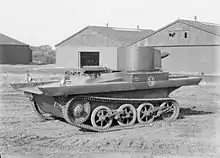Vickers-Carden-Loyd light amphibious tank
The Vickers-Carden-Loyd light amphibious tank (designated the A4E11 and A4E12 by the War Office),[1] was a series of British experimental pre-World War II light tanks (resembling tankettes), which, although not taken into British service, were sold to a number of other countries which produced modified versions which were then taken into service.
| Vickers-Carden-Loyd light amphibious tank | |
|---|---|
 | |
| Type | Amphibious tank |
| Place of origin | United Kingdom |
| Service history | |
| Used by | see text |
| Production history | |
| Designer | Carden-Loyd Tractors Ltd. |
| Manufacturer | Vickers-Armstrong |
| Produced | 1931–1932 |
| Specifications (A4E11, A4E12) | |
| Mass | 2.17 long tons (2.20 t) |
| Length | 13 ft 4 in (4.06 m) |
| Width | 6 ft 9 in (2.06 m) over tracks |
| Height | 6 ft 2 in (1.88 m) |
| Crew | 2 |
| Armour | 11 mm (0.43 in) |
Main armament | 0.303 inch Vickers machine gun with 1,000 rounds |
| Engine | Meadows petrol 6-cylinder 90 bhp |
| Suspension | Horstmann |
Operational range | 100 mi (160 km) |
| Maximum speed | 27 mph (43 km/h) on road; 3.72 mph (5.99 km/h) in water |
Users
Foreign buyers included China (29 or 32 tanks),[2] Thailand, the Dutch East Indies (two delivered in 1937)[3] and the USSR, with the latter producing some 1200 of the T-37A tanks developed from the A4E11/12. Poland was interested in Vickers-Carden-Loyd amphibious tanks in the 1930s, but negotiations failed and instead the PZInż works started the PZInż 130 project, an indigenous design inspired by the British concept.
Notes
- "British Light Tanks". Archived from the original on 14 August 2014. Retrieved 11 August 2014.
- Ledwoch, Janusz (2009), "Vickers 6-ton Mark E/F vol. II", Militaria no. 325 (in Polish), Warsaw, pp. 28–29, 34, ISBN 9788372193254
- Mahé, Yann (June 2011). "Le Blindorama : Les Pays-Bas, 1939 - 1945". Batailles & Blindés (in French). No. 43. Caraktère. pp. 4–7. ISSN 1765-0828.